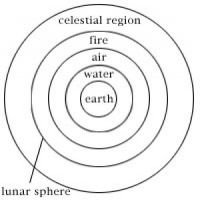
- Enlarge
- Diagramme of Aristotle's four elements
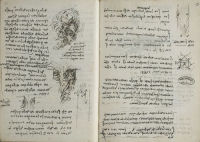
- Enlarge
- Zoom & explore
- Ms F Fol 18v-19r - The nature of water. Photo RMN - © René-Gabriel Ojéda
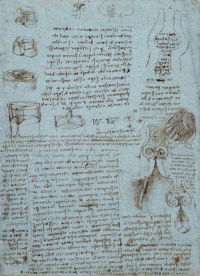
- Enlarge
- Zoom & explore
- Notes on the valves of the heart and flow of blood within it, The Royal Collection © 2005, Her Majesty Queen Elizabeth II
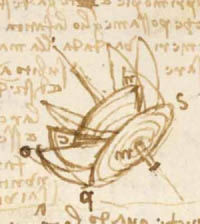
- Enlarge
- Codex Forster Book 1, Fol 44r - Studies of a pump for perpetual motion, detail © V&A Images, Victoria and Albert Museum
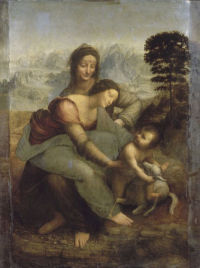
- Enlarge
- Zoom & explore
- Madonna, Child, St Anne and a Lamb, Photo RMN - © Daniel Arnaudet
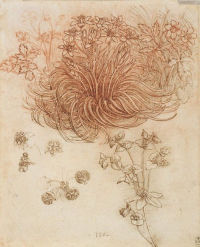
- Enlarge
- Zoom & explore
- Study of the Star of Bethlehem, The Royal Collection © 2005, Her Majesty Queen Elizabeth II
The vortex The paradise of mathematics
#2#
Leonardo famously said that
mechanics is the “paradise of mathematics”. Today, few might agree with
him in light of the complexities of the subject! In accordance with
Aristotle’s concept of science as a systematic inventory of the world,
he set out to classify vortices just as a botanist might classify
plants. Ultimately the task defeated him.
During his last years, the natural forces manifest in the gentle curls of the lamb’s coat in the Madonna, Child, St Anne and a Lamb,
and in the beautiful twisting motion of the leaves of the Star of
Bethlehem plant took on a destructive force in Leonardo’s artistic
imagination. In Ms A he wrote of “hollows in which the water, whirling
around in various eddies consumes and excavates and enlarges
chasms…consuming and devouring whatever stands in its path, changing
its course in the midst of the ruin.”
In the late Deluge Drawing
this prophetic vision of the destructive powers of nature is given full
visual expression. The turbulent forces that condition man’s existence
take the form of swirling vortices of air and water which have now
become synonymous with the uncontrollable and unknowable forces of
nature in Leonardo’s mind.
Movement in water and air was Leonardo’s greatest preoccupation. As the
most tangible evidence of natural force, spiraling forms and vortices
held a particular fascination. Their forms pervade the entire spectrum
of Leonardo’s work in the realms of hydraulics, anatomy, mechanics and
art.
- Size Water
#1#
As a “Master of water”, Leonardo needed to manage the movement of water and control its destructive, erosive power. He studied and recorded the movements of water under variable conditions repeatedly, adopting a scientific approach to the subject, as illustrated on Ms F Fol18v.
In the upper diagram, Leonardo illustrates the turbulent flow of water around a rectangular obstacle labeled “f”, noting that such “envelopings of courses” are caused by “the impetus of water under other water”. The lower water strikes the bottom first and immediately rises to the surface. The upper water does not descend, but when it encounters the rising water it collides with it and the two waters “unite and turn about together in their contact.”
In the second diagram, water cascades from the gate of a lock, falling into other water. That which is closest to the middle is “most oblique” and that which is closest to the extremities “most upright”.
Leonardo’s visualizations of water in motion in these drawings are not unlike the spiraling curls of hair. The visual appearance of natural phenomena was a natural consequence of its dynamic force. He remarks that “the motion of the surface of water resembles the behaviour of hair, which has two motions, of which one depends on the weight of the strands, the other on the line of its revolving; thus water makes revolving eddies, one part of which depends upon the impetus of the principle current, and the other depends on the incident and reflected motions.”





